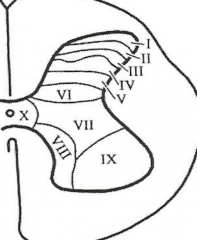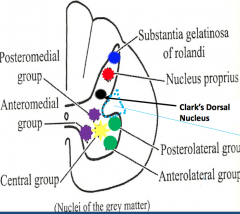![]()
![]()
![]()
Use LEFT and RIGHT arrow keys to navigate between flashcards;
Use UP and DOWN arrow keys to flip the card;
H to show hint;
A reads text to speech;
44 Cards in this Set
- Front
- Back
|
What are the laminae of the grey matter? |

1. Areas correspond to body parts/regions |
|
|
What are the nuclei of the posterior horn? |

1. Substantia gelatinosa 2. Nucleus prorpius 3. Clark's dorsal nucleus |
|
|
What are the conscious tracts? |
1. Gracile 2. Cuneate 3. Lateral spinothalamic 4. Ventral spinothalamic |
|
|
What is the function of the substantial gelatinosa? |
1. Pain and temperature
|
|
|
Where do the efferent fibers of the substantial gelatinosa cross and ascend? |
1. Cross in white commissure 2. Ascend in lateral column of white matter |
|
|
What is the sensory function of the nucleus proprius? |
1. Light pressure 2. Crude touch |
|
|
How do the fibers of the nucleus proprius cross and ascend? |
1. Cross opposite side in white commissure 2. Ascend in anterior white matter |
|
|
What is the afferent function of Clark's dorsal nucleus? |
1. Proprioception via collaterals from poster column white matter |
|
|
How do the fibers of Clark's dorsal nucleus ascend? |
1. No crossing 2. Ascend on same side in posterior spinocerebellar tract |
|
|
What is the efferent function of the medial anterior group? |
1. Innervate axial trunk muscles |
|
|
What is the efferent function of the lateral group? |
1. Innervate muscles of upper and lower limbs |
|
|
What is the efferent function of the central group? |
1. Runs in phrenic nerve to diaphragm 2. Innervate trapezius and SCM |
|
|
What sensation is carried in the gracile tract? |
1. Proprioception and fine touch from lower 1/2 of body |
|
|
What is the origin of the gracile and cuneate tracts? |
1. Cells of dorsal root ganglion central process |
|
|
Where does the gracile tract terminate? |
1. Gracile nucleus in closed medulla |
|
|
What sensation does the cuneate tract carry? |
1. Proprioception and fine touch from upper 1/2 of body |
|
|
What is the termination of the cuneate tract? |
1. Cuneate nucleus in closed medulla |
|
|
What sensation does the lateral spinothalamic tract carry? |
1. Pain and temperature 2. From opposite 1/2 of body BELOW THE HEAD |
|
|
What is the origin of the lateral spinothalamic tract? Termination |
1. Origin: axons of SGR cross in front of central canal 2. Termination: posterolateral ventral nucleus of thalamus--- PLVN |
|
|
What sensation does the anterior spinothalamic tract carry? |
1. Crude touch and light pressure 2. Opposite side of body below the head |
|
|
What is the origin of the anterior spinothalamic tract? Termination? |
1. Origin: axons of nucleus proprius 2. Termination: PLVN of thalamus |
|
|
What tracts carry unconscious sensations? |
1. Dorsal spinocerebellar 2. Ventral spinocerebellar 3. Spinoolivary 4. Spinotectal |
|
|
Where must all conscious sensations reach in the brain? |
1. Sensory area in postcentral gyrus |
|
|
From where do sensory areas in the cerebral hemisphere receive sensation? |
1. Opposite half of body |
|
|
How are sensations transmitted from receptors to sensory areas? |
1. 3 neurons--- 1o, 2o, 3o |
|
|
What is the 1st order neuron in sensation transmission? |
1. Lies in dorsal root ganglion 2. Peripheral process--- receives sensation from receptors 3. Central--- transmits to 2nd order neuron |
|
|
What are the 2nd order neurons in sensory transmission? |
1. Spinal cord: pain, temperature and touch 2. Medulla: proprioception and fine touch |
|
|
What are the 3rd order neurons for all sensation? |
1. Lie in PLVNT of OPPOSITE side 2. Subsequently pass to post central gyrus |
|
|
What will a lesion in the dorsal column lead to? |
1. Loss of proprioception--- high stepping and unsteady gait 2. Occurs in tabes dorsalis |
|
|
What is syringomyelia? |
1. Over-enlargement in the central canal of the spinal cord 2. Due to fusion of the central canal with cysts in the grey matter |
|
|
What is hydromyelia? |
1. Overdistension of the central canal with ependymal cell |
|
|
What are the ssx of syringomyelia? |
1. Selective loss of pain and temperature sensation 2. "Dissociated sensory loss"--- light touch and proprioception sensation preserved |
|
|
What are the destinations in cortical pain processing? |
1. Somatosensory cortex-- conscious recognition 2. Cingulate gyrus (limbic)--- emotional 3. Insular cortex----autonomic (pain, sweating) 4. Reticular formation--- on/off switch 5. Intraluminar nuclei of thalamus |
|
|
What is the first order neuron in the trigeminal pathway? |
1. Trigeminal ganglion |
|
|
What is the second order neuron in the trigeminal pathway? |
1. Main sensory nucleus 2. Spinal nucleus 3. Trigeminal nucleus |
|
|
What is the third order neuron in the trigeminal pathway? |
1. Posteromedial ventral nucleus of thalamus (PMVNT) |
|
|
What is the function of the main sensory nucleus in the trigeminal pathway? |
1. Crude touch |
|
|
What is the function of the spinal nucleus in the trigeminal pathway? |
1. Pain and temperature |
|
|
What is the function of the mesencephalic nucleus of trigeminal in the trigeminal pathway? |
1. Proprioception and fine touch |
|
|
What is the first order neuron in the dorsal spinocerebellar tract? |
1. Dorsal root ganglion |
|
|
What is the second order neuron in the dorsal spinocerebellar tract? |
1. Clark's nucleus in posterior horn of grey matter 2. Axons ascend in the SAME side of spinal cord 3. Pass through inferior cerebellar peduncle to reach cerebellum of same side |
|
|
What is the function of the ventral/dorsal spinocerebellar tract? |
1. Control muscle tone 2. Coordination of movements an posture of individual muscles of trunk and lower limb on SAME SIDE |
|
|
What types of lesions lead to loss of sensation contralaterally? |
1. Damage to sensory area of cerebral cortex 2. Damage to 2nd order neuron 3. Damage to 3rd order neuron |
|
|
What type of lesion will lead to loss of sensation ipsilaterally? |
1. Damage to first order neuron
|

